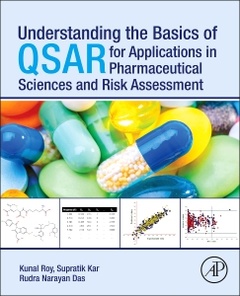Description
Understanding the Basics of QSAR for Applications in Pharmaceutical Sciences and Risk Assessment
Authors: Roy Kunal, Kar Supratik, Das Rudra Narayan
Language: English
Subject for Understanding the Basics of QSAR for Applications in...:
Keywords
3D-QSAR; 4D-QSAR; 5D-QSAR; 6D-QSAR; 7D-QSAR; Applicability domain (AD); Approved drug; Artificial neural network (ANN); COMBINE; Chemical assessment; Chemical attributes; Chemical graph theory; Chemical information; Chemometric tools; Classification; Clinical trial; CoRIA; Comparative molecular field analysis (CoMFA); Comparative molecular moment analysis (CoMMA); Comparative molecular similarity indices analysis (CoMSIA); Comparative spectral analysis (CoSA); Computer; Cosmetics QSAR; Database mining; De novo model; Descriptor; Descriptors; Docking; EQSAR; Electronic; Extrathermodynamic approach; G-QSAR; Graph theory; HQSAR; In silico; In silico success; Interspecies toxicity QSAR; LQTA-QSAR; Lead optimization; Linear discriminant analysis (LDA); Linear free-energy-related (LFER) model; MIA-QSAR; Mathematical model; Matrix; Mixed approach; Mixture toxicity QSAR; Model development; Modeling; Molecular dynamics (MD); Molecular mechanics (MM); Molecular shape analysis (MSA); Multiple linear regression (MLR); Nano-QSAR; Organisation for Economic Cooperation and Development (OECD); Partial least squares (PLS); Peptide QSAR; Pharmacophore; Physicochemical; Quantitative structure-activity relationship (QSAR); Quantum; Randomization; Receptor surface analysis (RSA); Regression; Self-organizing molecular field analysis (SOMFA); Semiempirical quantum mechanics; Simulation; Structural; Topological; Topology; Two-dimensional (2D) chemistry; Validation; Virtual screening; Weighted holistic invariant molecular (WHIM)
98.24 €
In Print (Delivery period: 14 days).
Add to cart484 p. · 19x23.3 cm · Paperback
Description
/li>Contents
/li>Readership
/li>Biography
/li>Comment
/li>
- Includes numerous practical examples related to QSAR methods and applications
- Follows the Organization for Economic Co-operation and Development principles for QSAR model development
- Discusses related techniques such as structure-based design and the combination of structure- and ligand-based design tools

